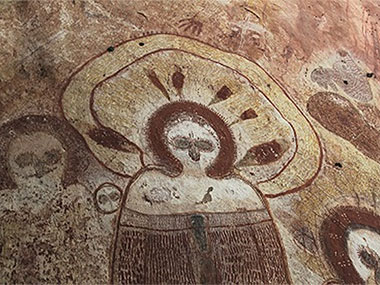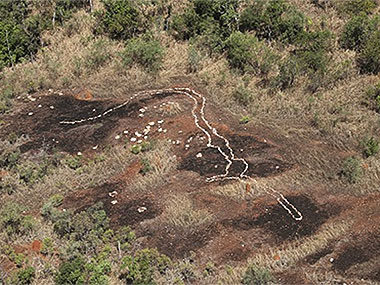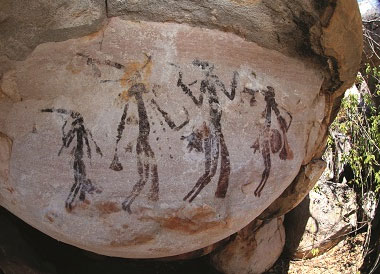WE ARE COMING TO SEE YOU

The Big Picture - a classic Wandjina, head surrounded by Woongudd the Snake with offspring Doombee/Dumbii the owl appearing behind a shoulder
Jeremy Eccles | 27.09.19
Author: Jeremy Eccles
News source: Review
This book is a rare treat in offering both fabulous pictures of rock art in the west Kimberley while also giving the local Gaambera, Wunambal and Dambeemangaddee peoples' understanding of that art and its relevance to their lives today. The result is fascinating - and just occasionally confusing. Having two different language orthographies, for instance, popping up doesn't always help, Wanjina/Wandjina, Woongudd/Wunggurr and Gwion/Gyorn.
But then, I'm further confused by my contact with the Kira Kiro people of the Ngarinyin tribe who seem to share the old Catholic mission at Kalumburu with the Wunambal and Gaambera, but have a very different view about the chronology and hierarchy of the Lalai/Dreaming – which they call Wunan. Most significantly, the Kira Kiro people see their Gwions as the mythical beings that created the Wunan and the law; while the language groups in the book clearly rate the Wanjina as senior and original beings – along with the Snake/Woongudd – and, for them, Gwions are mere helpmates who manage the land sustainably and help humans to achieve that.
This, of course, raises the whole hoary issue of Grahame Walsh and his disputed chronology of what he called Bradshaw figures. Walsh's timelines do, however, largely accord with current archaeological research by the Kimberley Foundation (also working with the Wunambal Gaambera people) which suggests that Gwion Gwion people inhabited the west Kimberley on their own, creating those elegant dancing figures on cave walls, until the end of the Ice Age around 10,000 years ago. At that point in time, the Arafura Plains (now offshore) flooded, forcing its Wanjina people onshore to share their land and cave art with the Gwion/Kira Kiro people.
Fortunately, the late Traditional Owner Sylvester Mangolamara admits “we can't stop whitefellas (like me) speculating, but we have to have our words out first”. Indeed, the primary market for this book is “for the future generations of Wanjina-Wunggurr Traditional Owners”. And Mangolamara is pretty clear that he has no time for “the archaeologists or rock art specialists (who) have tried to categorise the images and paintings in our Country and the stones that mark the evidence of Lalai, into stylistic groups in relative age order – which is disrespectful to the very substance of Lalai”. Meanwhile, artist and TO, Donny Woolagoodja distinguishes between the ways aalmara (whitefellas) and his people define culture: “Culture to them is what they think; to us culture is the land and what is in it and every picture has a story”.
Indeed, “We Are Coming to See You” has many pictures and a multiplicity of stories. But there are a couple of alternative ways suggested as to how the pictures got on to the cave walls of The Kimberley. One view has it that the Wanjina and the Woongudd Snake created everything around them “when the world was soft, like bulldozers”, then “they left their shadows, their images on the walls of caves”. So we're not looking at paintings, but rather at “imprints, shadows or the essence and silhouettes of Wanjinas”. Later it's posited that the Gwion/Gyorn were instructed by the Wanjina Mereewoon to “do all the painting as Little Birds”.
Which brings back memories of a period when some west Kimberley people appeared to deny their own links to the Gwion Gwion figures because they'd been pecked into the rock by birds.
But, anyway, today's visitors are almost certainly seeing painting rather than those deliciously evocative “imprints” of Wanjina. For there's acceptance in the book that repainting and re-incising an image is a way “to wake him up to make rain” - the key ongoing role for the Wanjinas and Woongudd. And it's possible to refresh the Wanjina “so they can smile again”.
Tricky – though, for Wanjinas never have a mouth! Another whitefella to speculate on that absence was the late great poet and playwright, Billy Marshall Stoneking. In his play about the silence of American poet, Ezra Pound during his treason trial after World War II, he made a link to the Wanjinas, who, once they had created everything in The Kimberley by simply naming it, had to have their mouths removed to stop them over-filling that world. Donny Woolagoodja has a much more fundamental rationale: “Wandjina has no mouth because the sound of beginning cannot be heard by human ears”.
And that's the man who designed the massive Wandjina cloth that floated down during the Olympics 2000 Opening Ceremony. “We can only hear him talking in the rumbling that comes from thunder”, he adds. Cyclones require the combined efforts of Wandjina and Woongudd, and in the middle you may see the eye of the Woongudd. “Safe rain”, on the other hand, requires “people to work with the Wandjinas”.
Another definitive assessment of Donny Woolagoodja is that his mob “always knew the world was round” because it was shaped “by two snakes chasing each other round and round” from daylight into darkness.
As well as being resting places for 'retired' Wanjinas – male and female, by the way – caves and rock shelters seem have been places where sex and childbirth could be explained through painting, where a man could request a child by adding its image to the shoulder of the appropriate Wanjina. Mind you, the child then emerged from a water source such as Punamii/Mitchell Falls, where unborn spirits awaited their birth, and where the dead would retreat to await rebirth.
Beneath the surface, “Wunggurr stop in the water all the time”.
But, images of rock formations, both natural and clearly man-made, make it clear that Wunggurr may be represented on the land as well as imagined beneath the waters.
In the rock shelters and caves, many other critters make their appearances – the most intriguing being the saltwater croc, who, far from being the terrifying figure of Arnhemland repute, “put himself on the cave wall (like the Wanjina) and is looking after Country and the families connected to it”. Another surprise is the Flying Fox, there as “the main one for making man ceremonies” (ie initiation). Less surprising, Jilinya, the enticing bush-woman, always appears with her legs apart “to lead men astray” by encouraging “the man to rub”! For young girls, on the other hand, 'model' figures remind them “not to get bulgy”!
Finally, going back to Kalumburu's chronological dissonance between its Gwion Gwion people and its Kira Kiro people, the rock walls reveal evidence of battles and there's textual reference to “a big war”. Could this have been the struggle for territory as the Ice Age ended and the Wanjina/saltwater people arrived? For there's mention of the Wanjinas making war because Dumbii the Owl (a Wanjina offspring) had his feathers pulled out by boys. And that war caused a massive flood – which is just what the arrival of melting Ice Age waters must have felt like.
Just speculating, of course! But worth a thought as the United Nation announces that sea levels could rise by 1.1 metres during the 21st Century, which could easily lead the Wanjinas and others to go to war again.
I leave you with the generous offer of a younger generation of Gaambera, Wunambal and Dambeemangaddee peoples in the persons of Rowena Mouda and Catherine Goonack who end this marvellous tome by “inviting you to think about our rock art and stone arrangements based on our way of understanding them and reading the Country”.
'We Are Coming to See You' has a RRP of $96. Availability should be national, but recommended are Mowanjum art centre, sales@mowanjumarts.com and the Kimberley Bookshop in Broome.
URL: http://dambimangari.com.au/
Share this:
»  del.icio.us
»
del.icio.us
»  Digg it
»
Digg it
»  reddit
»
reddit
»  Google
»
Google
»  StumbleUpon
»
StumbleUpon
»  Technorati
»
Technorati
»  Facebook
Facebook
Contact Details

The mythic Woongudd/Wunggurr laid out on rocks in female form, with eggs contained within the curve of her serpentine body

The somewhat battered Gwion/Gyorn/Kira Kiro figures dancing on a rock shelter, providing models for today's ceremonial outfits
Further Research
Artists: Donny Woolagoodja | Jack Karadada | Janet Oobagooma | Lily Karadada | Sylvester Mangolamara
News Tags: Billy Marshall Stoneking | Grahame Walsh | Gwion Gwion | Jeremy Eccles | Kalumburu | Kimberley Foundation | Kira Kiro | The Kimberley | Wandjina
News Archive
- 02.10.19 | FIBRE ALCHEMY
- 27.09.19 | WE ARE COMING TO SEE YOU
- 19.09.19 | Mparntwe Muddles On
- 17.09.19 | Fondation Opale Glows Opalescent
- 13.09.19 | 'Mapa Wiya' (Your Map’s Not Needed)
- 08.09.19 | Sydney Goes Contemporary
- 04.09.19 | Victorian Bonanza!
- 31.08.19 | Woven Furniture
- 29.08.19 | Funding for Indigenous Art
- 27.08.19 | Movement at the Station in Alice
- 16.08.19 | THE NIGHTINGALE
- 14.08.19 | NINGALI
- 09.08.19 | 2019 Telstra NATSIAAs
- 31.07.19 | Save the Date - Tarnanthi in October
- 22.07.19 | The McKenzie Powerhouse
Advertising

